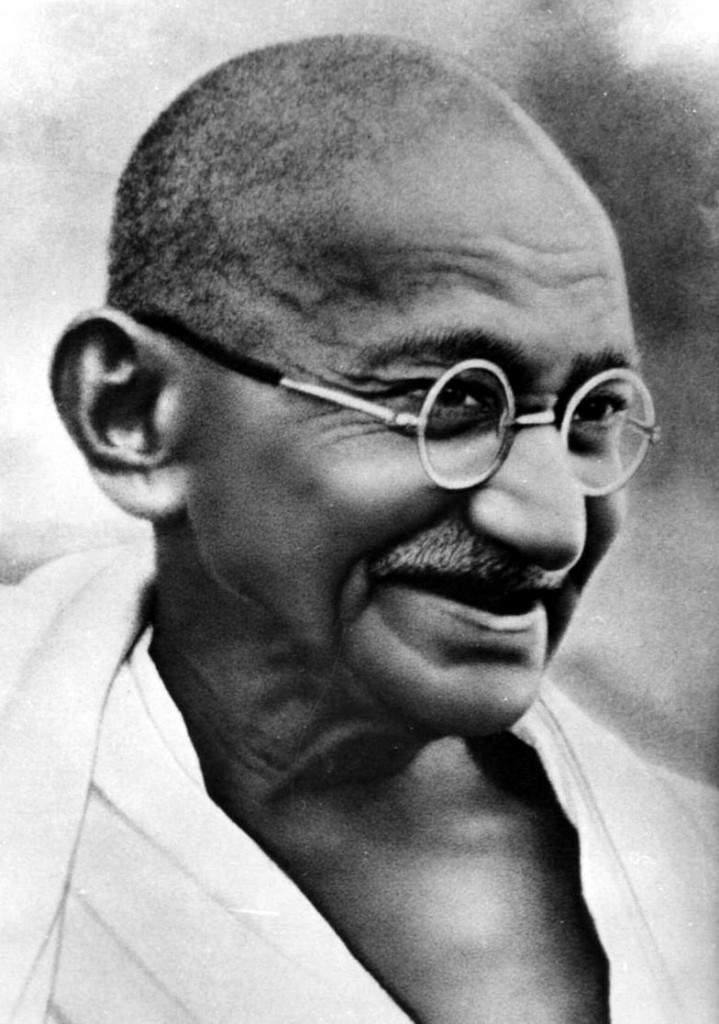Lok Sevak Sangh: The Servants of the People

Gandhi, c.1948; public domain image, courtesy commons.wikimedia.org; photographer unknown.
After Indian independence, Gandhi advocated the dissolution of the main political party, the Indian National Congress, which he had previously led. The struggle had shifted, he said, from securing independence to seeing to the needs of the people. Party politics could not serve this purpose and so he conceived of more localized structures to be called Lok Sevak Sangh, or the Servants of the People. Just weeks before his assassination, Gandhi drafted a constitution for Lok Sevak Sangh, which Geoffrey Ostergaard refers to in his article also posted today. Lok Sevak Sangh has not been given enough attention, but bears comparison with anarcho-syndicalism, the Muslim Brotherhood’s social program, or the current emphasis of the Occupy Movement on social programs. The draft constitution was published on 15 January 1948. Two weeks later, on 30 January, Gandhi was assassinated.
The Draft Constitution:
Though split into two, India having attained political independence through means devised by the Indian National Congress, the Congress in its present shape and form, i.e., as a propaganda vehicle and Parliamentary machine, has outlived its use. India has still to attain social, moral and economic independence in terms of its villages as distinguished from its cities and towns.
The struggle for the ascendancy of civil over military power is bound to take place in India’s progress towards its democratic goal. It must be kept out of unhealthy competition with political parties and communal bodies. For these and other similar reasons, the AICC resolves to disband the existing Congress organization and flower into Lok Sevak Sangh, the Servants of the People, under the following rules with power to alter them as occasion may demand.
Each self-governing unit (panchayat) shall consist of five adult men or women being villagers or village-minded. Two contiguous units (panchayats) shall form a working party under a leader elected by them.
When there are 100 panchayats, 50 first-tier leaders shall elect from among themselves one second-tier leader and so on. The first-tier leaders will work under the second-tier leader. Such units will continue to be formed until they cover the whole of India, each of these electing one second-tier leader after the manner of the first. All second-tier leaders shall serve conjointly both for the whole of India and for their respective areas. Whenever they deem it necessary, the second-tier leaders may elect from among them a Chief who will, during his tenure, regulate and command all the groups.
(The final formation of provinces or districts of India being still in a state of flux, no attempt has been made to divide the groups of Servants into provincial or district councils. It should be noted that the Servants derive their authority or power from service, unreservedly and wisely carried out in the name of their master, that is, the whole of India.)
The following rules adhere to the leaders:
1. Every worker shall be a habitual wearer of self-spun yarn (khadi) or wear cloth that is certified by the All India Spinners Association (AISA). Every worker must be a teetotaler. If a Hindu, he must have abjured untouchability in any shape or form in his own person or in his family and must be a believer in the ideal of inter-communal unity, equal respect and regard for all religions, and equality of opportunity and status for all irrespective of race, creed, or gender.
2. He shall make personal contact with every villager within his jurisdiction.
3. He shall enroll and train workers from among the villagers and keep a register of all of these.
4. He shall keep a record of his work from day to day.
5. He shall organize the villages so as to make them self-contained and self-supporting through their agriculture and handicrafts.
6. He shall educate the village folk in sanitation and hygiene and take all measures for prevention of ill health and disease in his constituency.
7. He shall organize the education of the village folk from birth to death adhering to the principle that work and knowledge are one (Nayee Talim), in accordance with the policy laid down by the Hindustani national educational standards (Talimi Sangh).
8. He shall see that those whose names are missing on the statutory voters list are duly sought out and registered.
9. He shall encourage all those who have not yet acquired the legal qualification for getting the right to vote, to acquire it.
10. For the above purposes and others to be added from time to time, he shall train and fit himself in accordance with the rules laid down by the Sangh for the due performance of his duty.
The Sangh shall include the following autonomous organizations:
1. All India Spinners Association
2. All India Village Industries Association
3. Hindustani Talimi Sangh
4. Harijan Sevak Sangh
5. Goseva Sangh
The Sangh shall raise finances for the fulfillment of its mission from among the villagers and others, special stress being laid on the collection of poor man’s pennies.
A NOTE ON THE TEXT: This was frst published in Gandhi’s periodical, Harijan, 15-1-1948. There are two ready versions online, with some variants of text. See, for example, the mkgandhi.org site, although the version at Gandhi-manibhavan seems more accurate. We have combined these for this posting.




